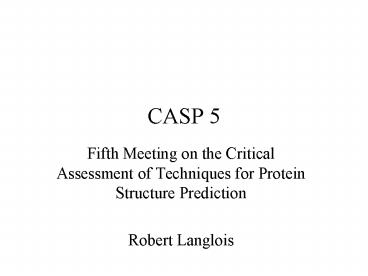CASP 5 PowerPoint PPT Presentation
1 / 31
Title: CASP 5
1
CASP 5
- Fifth Meeting on the Critical Assessment of
Techniques for Protein Structure Prediction - Robert Langlois
2
Purpose
- Establish in structure prediction from sequence
- Capabilities
- Limitations
- Accomplished by analysis of a large number of
blind predictions
3
Prediction Categories
- CASP 5
- Comparative Modeling
- Fold Recognition
- New Fold methods
- CAFASP 3
- Automated Servers
4
Category Target Overlap
Comparative Modeling
Fold Recognition
Ab Initio
5
Comparative Modeling
- Exploit evolutionary relationships to produce 3D
structures - Has not changed in a few decades
- General Protocol
- Start by identifying the template
- Align sequences of target and template
- Model conserved then diverged regions
- Assign side chain conformations, refine model
6
Scoring
- GDT-TS
- Global distance test
- Number of Ca in prediction not deviating more
than di from Ca in the target - Under the condition of optimal super-position
- RMSD of Ca
- Percent of Correctly Aligned Residues
7
Comparative Modeling Results
- Over 39 proteins, consisting of 51 domains
- Able to identify templates with 6 identity
- Improvement of CASP4, lt17 identity
- Top 5 groups Initial predictions
- Murzin Knowledge-based personal approach
- Bujnicki-Janusz Automatic servers
- VENCLOVAS Multiple sequence alignment
- Ginalski Automatic servers
- GeneSilico
8
Group Results cont.
448 Murzin 425 VENCLOVAS 020 Bujnicki 453
Ginalski 517 GeneSilico
9
Overall Results
- Servers better than most human predictors
- 3D Shotgun meta-predictor
- Bakers ROBETTA server
- However, no group was able to optimize
- I.e. create many good models but cannot pick the
best - No model comes significantly closer to target
than the template
10
Overall Results cont.
11
CM Conclusion
- Successes
- Matching template to target
- Performance of different methods has leveled
- Failures
- Cannot produce model, closer than template
- Cannot model features not inherited
- Future select the best of several models
12
Fold Recognition
- Common approaches taxonometric (SVM, NN.),
threading, homology modeling - Combines fold recognition, comparative modeling,
and de novo approaches
13
Fold Recognition Methods
- Template based combines
- Correct template, comparative modeling and fold
recognition servers - Refinement, available programs, and manual
inspection - Ginalski
- Fragment Assembly Ab initio
- Rosetta identify small fragments from a library
of existing structures - TOUCHSTONE conserved contacts threading
14
Scoring
- Livermore GDT_TS, SOV_O, and LGA_Q
- 3 structural superposition, 2 sequence depend
- Incorporate scores from
- Dali http//www.ebi.ac.uk/dali/
- CE http//cl.sdsc.edu/ce.html
- Mammoth http//icb.mssm.edu/services/
- Dali CE compare intra molecular Ca geometries
- Mammoth structural alignments independent of
contact maps, depend on unit vector RMSD distances
15
Fold Recognition Results
- Top 3 Outperform the Rest
- Baker comparative modeling and ab initio
- Ginalski combine servers and manual inspection
- Rychlewski meta-server 3D Jury
16
Top 20 Predictors
17
Example Rossmann-like a/ß
18
Multi-domain Failures
19
Prediction Beats Template
20
Unrealistic Models Scoring Well
21
Conclusions
- While overall scores are higher than CASP4
- Does it reflect better predictions or larger
database? - Automatic servers nearly reach manual predictions
22
New Fold Techniques
- Ab Initio Folding Engine
- Metropolis Rule
- Potentials
- Successful Groups use
- Fragment Methods
- Contact Maps
23
Scoring
- RMSD, LCS, SOV, GDT_TS, Visual
- GDT_TS agreed best with visual inspection
- LCS CASP3 holdover
- Sequence dependent structural alignment
24
Example (NF) H. in?uenzae
25
Example (NF) E. coli
26
Visual Table Results
27
Summary of Methods
28
Discussion
- Fragment methods better at choosing fragments
than assembling them. - Automatic Servers similar performance
- PROTINFO-AB, I-site/Bystroff, BAKER-ROBETTA
- 20 out of 25 groups use PSI-PRED
29
Conclusions
- Coordinate Predictions
- Impressive accuracy
- Shows great progress in understanding folds
- Convergence of fold recognition
- Fragment template library construction
- Secondary Structure
- Have reached limits
30
Conclusions cont.
- Residue-Residue Contacts
- Very limited improvement
- Fragment templates, better accuracy
- Not accurate enough to build a model from scratch
31
References
Aloy, P., A. Stark, et al. (2003). "Predictions
Without Templates New Folds, Secondary
Structure, and Contacts in CASP5." PROTEINS
Structure, Function, and Genetics 53
436-456. Kinch, L. N., J. O. Wrabl, et al.
(2003). "CASP5 Assessment of Fold Recognition
Target Predictions." PROTEINS Structure,
Function, and Genetics 53 395-409. Tramontano,
A. and V. Morea (2003). "Assessment of
Homolgy-Based Predictions in CASP5." PROTEINS
Structure, Function, and Genetics 53 352-368.

